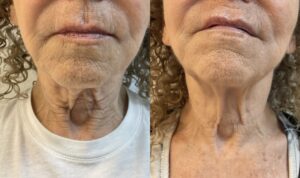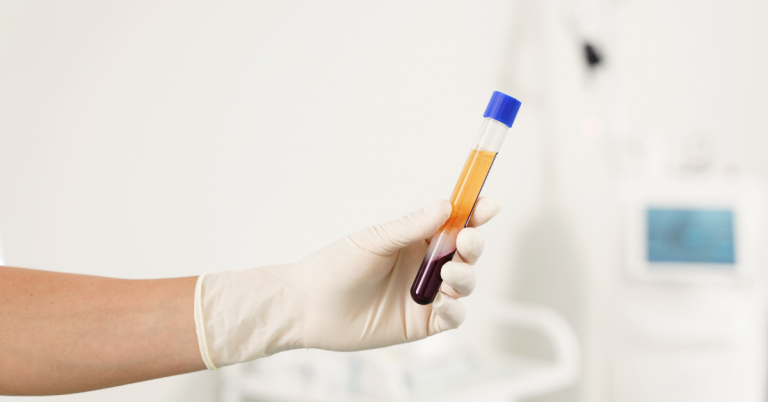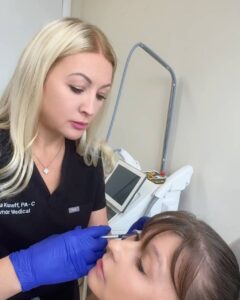Introduction to PRP Microneedling
When it comes to achieving youthful, radiant skin, there are countless treatments and procedures available. One such treatment that has gained immense popularity in recent years is PRP Microneedling. This cutting-edge procedure combines the power of Platelet-Rich Plasma (PRP) with the rejuvenating effects of microneedling to deliver incredible results. If you’re looking for a non-invasive, safe, and effective way to rejuvenate your skin, PRP Microneedling may be just what you need.
How does it work?
PRP Microneedling works by harnessing the power of your body’s natural healing process. The procedure begins with a small amount of your blood being drawn. This blood is then placed in a centrifuge to separate the platelet-rich plasma from the rest of the blood. The resulting PRP is rich in growth factors and other beneficial components that promote tissue regeneration and collagen production.
Once the PRP is prepared, a microneedling device is used to create tiny punctures in the skin. These micro-injuries stimulate the body’s natural healing response and allow the PRP to penetrate deeper into the skin. As the skin heals, new collagen is produced, resulting in smoother, firmer, and more youthful-looking skin.
Benefits of PRP Microneedling
PRP Microneedling offers a multitude of benefits for the skin. Firstly, it helps to improve the overall texture and tone of the skin, reducing the appearance of fine lines, wrinkles, and scars. The procedure also promotes the production of new collagen. This helps to plump the skin and reduce the signs of aging.
In addition to anti-aging effects, PRP can also help with skin concerns such as hyperpigmentation, acne scars, and stretch marks. The growth factors in PRP promote cell turnover, helping to fade dark spots and even out skin tone. The procedure is also effective in reducing the appearance of acne scars and can improve the texture of the skin in areas affected by stretch marks.
Benefits of PRP hair restoration
PRP hair restoration offers several benefits for individuals struggling with hair loss. Firstly, it is a non-surgical and minimally invasive procedure. Unlike hair transplant surgery, PRP does not require any incisions or sutures. This means that there is minimal downtime and discomfort associated with the treatment.
Additionally, PRP hair restoration utilizes your body’s natural healing properties. The platelet-rich plasma is derived from your own blood, reducing the risk of allergic reactions or adverse side effects. PRP is safe and well-tolerated by most individuals.
Another benefit of PRP hair restoration is its versatility. It can be used to treat various types of hair loss, including androgenetic alopecia, alopecia areata, and even thinning hair due to aging. PRP stimulates hair growth and improves hair quality, regardless of the underlying cause of hair loss.
Furthermore, PRP hair restoration is a long-lasting solution. While individual results may vary, many patients experience sustained hair growth and improvement in hair density. Maintenance sessions may be recommended to optimize and maintain the results.
The science behind PRP Microneedling
The science behind PRP Microneedling lies in the powerful properties of platelet-rich plasma. Platelets are responsible for clotting blood and initiating the healing process in the body. They also contain growth factors that play a crucial role in tissue repair and regeneration.
When PRP is applied to the skin, it stimulates the production of collagen and elastin. These two proteins are essential for maintaining youthful skin. Collagen helps to support the structure of the skin, while elastin gives the skin its elasticity. By boosting the production of these proteins, PRP Microneedling helps to restore the skin’s natural firmness and elasticity.
What to expect during treatment
If you’re considering PRP Microneedling, it’s natural to wonder what the treatment entails. The procedure typically begins with a consultation with a trained aesthetic professional who will assess your skin and determine if you’re a suitable candidate. Once you decide to proceed with the treatment, a small amount of blood will be drawn from your arm.
The blood is then processed in a centrifuge to separate the PRP from the rest of the blood. While the PRP is being prepared, a numbing cream will be applied to your skin to ensure your comfort. Once ready, the aesthetic professional will use a microneedling to create tiny punctures in your skin and apply the PRP topically.
During the treatment, you may experience a mild tingling or prickling sensation, but it is generally well-tolerated. The procedure typically takes around 30-60 minutes, depending on the area being treated. Afterward, your skin may appear slightly red and feel sensitive, similar to a mild sunburn. These effects usually subside within a day or two.
The benefits of combining PRP with Microneedling
While microneedling alone can produce significant improvements, combining it with PRP takes the results to a whole new level. By adding PRP to the microneedling procedure, you are essentially supercharging the treatment and enhancing its effectiveness.
PRP contains a high concentration of growth factors that help to accelerate the healing process and promote collagen production. When during microneedling, PRP penetrates deeper into the microchannels, delivering its rejuvenating properties directly to the target area. This combination results in enhanced collagen synthesis and even better skin rejuvenation.
Furthermore, the addition of PRP can also help to reduce the downtime associated with microneedling. PRP has natural healing properties that can aid in the recovery process, allowing you to resume your regular activities sooner. The combination of PRP and microneedling truly offers a comprehensive and powerful solution for achieving radiant, youthful skin.
How to prepare for a PRP Microneedling treatment
Before undergoing a PRP Microneedling treatment, there are a few steps you can take to ensure optimal results. It is important to avoid sun exposure and tanning beds for at least two weeks prior to the procedure. This exposure can increase the risk of post-treatment complications. Additionally, it is recommended to discontinue the use of skincare products containing retinol or acids a few days before the treatment.
It is also crucial to stay well-hydrated and maintain a healthy diet leading up to the procedure. Proper hydration helps to optimize blood flow and improve the effectiveness of the treatment. Lastly, inform your aesthetic professional about any medications or supplements you are currently taking. Some supplements or products may need to be temporarily discontinued to minimize the risk of complications.
By following these pre-treatment guidelines, you can ensure that your skin is in the best possible condition for the procedure, maximizing its benefits.
Aftercare and recovery tips
After undergoing a PRP Microneedling treatment, it is essential to take proper care of your skin. Your aesthetic professional will provide you with detailed aftercare instructions, but here are some general tips to keep in mind.
Immediately after the treatment, it is normal for your skin to appear red and feel sensitive. Avoid touching or rubbing the treated area to prevent infection and irritation. Additionally, it is important to avoid direct sun exposure and wear a broad-spectrum sunscreen with at least SPF 30.
To promote healing, keep your skin well-moisturized and avoid using harsh skincare products for a few days. It is also advisable to avoid strenuous exercise, saunas, and hot showers for at least 48 hours post-treatment. These activities can increase blood flow and potentially cause complications.
Following the recommended aftercare guidelines will help ensure a smooth recovery and optimize the results.
Frequently asked questions about PRP Microneedling
- Is PRP Microneedling painful? The procedure is generally well-tolerated, thanks to the numbing cream applied prior to treatment. While some mild discomfort or tingling may be experienced during the procedure, it is usually minimal.
- How many sessions of PRP Microneedling are needed? The number of sessions required varies depending on individual needs and goals. Typically, a series of 3-6 treatments spaced 4-6 weeks apart is recommended for optimal results.
- Are there any side effects or risks associated with PRP Microneedling? The procedure is considered safe when performed by a trained professional. Mild side effects such as redness, swelling, or bruising may occur, but they usually subside within a few days.
- When will I see results from PRP Microneedling? Results are typically noticeable within a few weeks after the first treatment, with continued improvement over time as collagen production increases.
- Can PRP Microneedling be combined with other treatments? Yes, PRP Microneedling can be combined with other treatments such as laser therapy or injectables to further enhance the results.
Is PRP Microneedling the ultimate skin rejuvenation treatment?
PRP Microneedling has revolutionized the field of skin rejuvenation. Offering a safe, effective, and non-invasive solution for achieving youthful, radiant skin. By harnessing the power of platelet-rich plasma and microneedling, this treatment stimulates collagen production, improves skin texture and tone, and addresses various skin concerns such as fine lines, wrinkles, scars, and hyperpigmentation.
If you’re interested in experiencing the magic of PRP Microneedling for yourself, book a consultation with Glamor Medical. We will assess your skin and determine if PRP Microneedling is the right treatment for you. Don’t wait any longer to unveil the beautiful skin you deserve. Book your consult today and discover the ultimate skin rejuvenation treatment that is PRP Microneedling.




